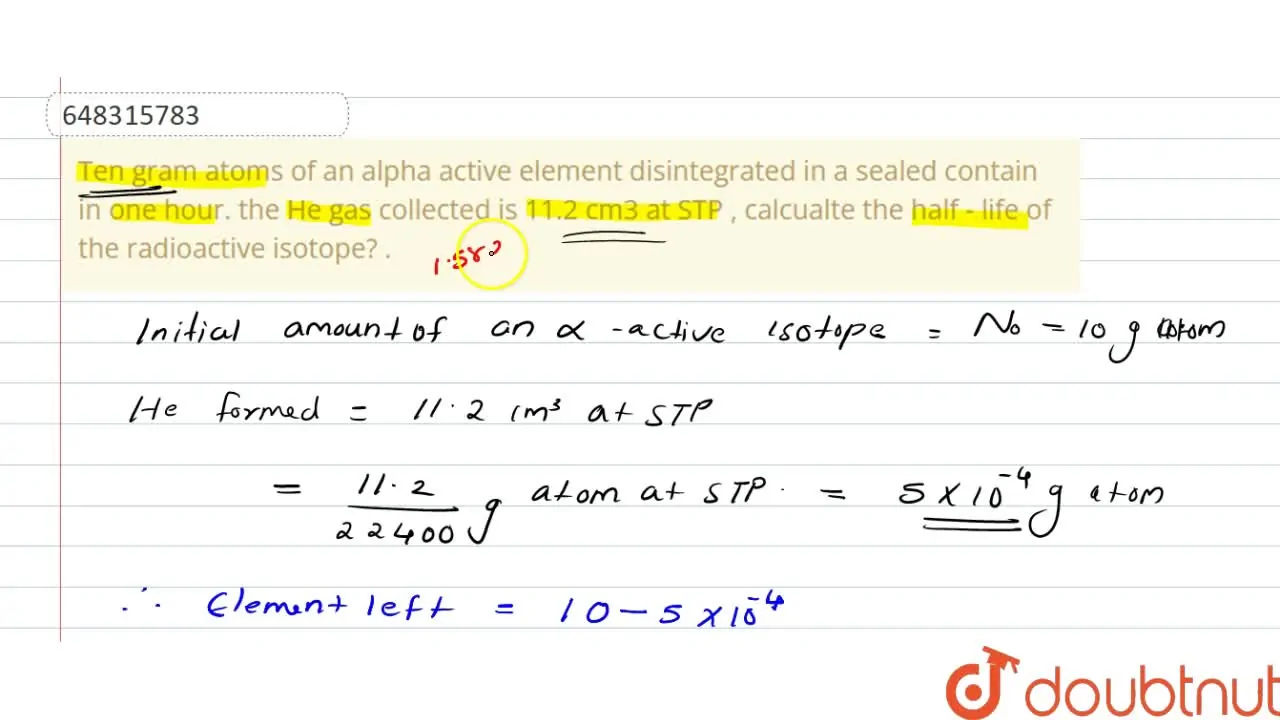Ten gram atoms of an alpha active element disintegrated in a sealed contain in one hour. the He gas collected is 11.2 cm3 at STP , calcualte the half - life of the radioactive isotope? .
The correct Answer is:13860 hr
Step by step video & image solution for Ten gram atoms of an alpha active element disintegrated in a sealed contain in one hour. the He gas collected is 11.2 cm3 at STP , calcualte the half - life of the radioactive isotope? . by Chemistry experts to help you in doubts & scoring excellent marks in Class 12 exams.
Similar Questions
10 g-atoms of an α-active radioisotope are disintegrating in a sealed container. In one hour the helium gas collected at STP is 11.2cm2. Calculate the half life of the radioisotope.
View SolutionThe radioactive decay rate of a radioactive element is found to be 103 disintegration per second at a cartain time . If the half life of the element is one second , the dacay rate after one second ….. And after three second is ……
View SolutionThe radioactive decay rate of a radioactive element is found to be 103 disintegration per second at a certain time . If the half life of the element is one second , the decay rate after one second is?
View SolutionIf 3/4 quantity of a radioactive substance disintegrates in 2 hours, its half− life period will be
View Solution(a) Calculate the activity of one mg sample .28Sr90 whose half life period is 28 years.
(b) An experiment is performed to determine the half-life of a radioactive substance which emits one beta particle for each decay process. Observation shown that an average of 8.4β−particles are emitted each second by 2.5mg of the substance. the atomic weight of the substance is 230. calculate the half0life of the substance.
(c) Determine the quantity of .84Po210 necessary to provide a source of alpha particle of 5mCi strength (T1/2 for Po =138 day).View SolutionA bottle of red wine is thought to have been sealed about 5years ago. The wine containa a number of different kinds of atoms, incluing carbon, oxygen,and hydrogen. Each of these has a radioactive isotope. The radiaoctive isotope of carbon is the familiar .146C with a half-life of 5730years. The radioactive isotope of oxygen is. .158O and has a half-life of 122.2s. The radioactive isotope of hydrogen .31H and is called tritium, its half-life is 12.33years. The activity of each of these isotopes is known at the time the bottle was sealed. However, only one of the isotopes is useful for determining the age of the wine accurately. Which is it?
View SolutionRadioactive disintegration is a first order reaction and its rate depends only upon the nature of nucleus and does not depend upon external factors like temperature and pressure. The rate of radioactive disintegration (Activity) is represented as
−dNdt=λN Where λ= decay constant, N= number of nuclei at time t, N0 =intial no. of nuclei. The above equation after integration can be represented as
λ=2.303tlog(N0N)
Calculate the half-life period of a radioactive element which remains only 1/16 of its original amount in 4740 years:View SolutionNuclei of a radioactive element A are being produced at a constant rate α. The element has a decay constant λ. At time t=0, there are N0 nuclei of the element.
(a) Calculate the number N of nuclei of A at time t.
(b) If α=2N0λ, calculate the number of nuclei of A after one half-life of A, and also the limiting value of N as t→∞.View SolutionTwo radioactive substance X and Y initially contain equal number of nuclei. X has a half life of 1 hour and Y has a half-life of 2 hours. After 2 hours the ratio of activity of X to that of y is
View SolutionIn an experiment on two radioactive isotopes of an element (which do not decay into each other), their number of atoms ratio at a given instant was found to be 3. The rapidly decaying isotope has large mass and an activity of 1.0μCi initially. The half-lives of the two isotopes are known to be 12 hours and 16 hours. what would be the activity of each isotope and their number of atoms ration after two days?
View Solution


